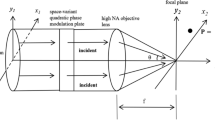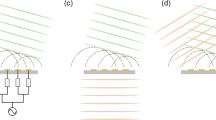Abstract
The effect of beam waist radius on the radiation properties of electrons in the presence or absence of an applied magnetic field is comparatively investigated when Gaussian circularly polarized laser pulse drives electrons for relativistic nonlinear Thomson forward scattering. This effect will be investigated in terms of the electrodynamic properties of high-energy electrons, the full-angular distribution of radiated power and the spectral properties. We study the coupling effect of the crossover parameter, the applied magnetic field and the beam waist radius. Based on theoretical analyses and numerical calculations, we find that the various radiation properties at different beam waist radii are consistent. And there always exists an optimal beam waist radius, which makes the stimulated radiation of high-energy electrons high-power, highly-collimated, well-directed, wide-frequency-domain, and super-continuous, when Gaussian laser drives the electron oscillating. Moreover, we found that the radiation properties are significantly improved in all directions when an applied magnetic field is introduced. Accordingly, we select the optimal beam radius on the basis of the applied magnetic field. After numerical simulations, we developed a modulation method for \(X\)-rays with optimal radiation properties. The above study is a pioneering guide for modulation of \(X\)-rays in optical laboratories.














Similar content being viewed by others
References
T.H. Maiman, Nature 187, 493–494 (1960)
J.L. Wentz, Proc IEEE Inst Electr Electron Eng 52, 6 (1964)
M.A. Kovacs, G.W. Flynn, A. Javan, Appl. Phys. Lett. 8, 3 (1966)
P.W. Smith, Proc IEEE Inst Electr Electron Eng 58, 9 (1970)
H.A. Haus, IEEE J Sel Top Quant 6, 6 (2000)
P. Maine, D. Strickland, P. Bado et al., IEEE J Quant Electron 24, 2 (1988)
A. Galvanauskas, IEEE J Sel Top Quant 7, 4 (2001)
S. Witte, K.S. Eikema, IEEE J Sel Top Quant 18, 1 (2011)
X. Yang, Z. Xu, Y. Leng et al., Opt. Lett. 27, 13 (2002)
U. Keller, Nature 424, 6950 (2003)
S. Backus, C.G. Durfee III., M.M. Murnane et al., Rev. Sci. Instrum. 69, 3 (1998)
D.M. Perry, G. Mourou, Science 264, 5161 (1994)
S. Corde, K.T. Phuoc, G. Lambert et al., Rev. Mod. Phys. 85, 1 (2013)
D.J. Corvan, M. Zepf, G.A. Sarri, Nucl Instrum Meth A 829, 291–300 (2016)
V.S. Letokhov, Nature 316, 6026 (1985)
M.L. Wolbarsht, Laser applications in medicine and biology (Springer, New York, Plenum Press, 1971)
J.L. Boulnois, Lasers Med. Sci. 1, 47–66 (1986)
M. Protopapas, C.H. Keitel, P.L. Knight, Rep. Prog. Phys. 60, 4 (1997)
H. Takabe, Prog. Theor. Phys. Suppl. 143, 202–265 (2001)
Z. Chen, Q. Chen, H. Qin et al., Chinese J Light Scatter 34, 2 (2022)
X. Zhang, D. Chen, Y. Tian, Appl Phys B-Lasers O 129, 135 (2023)
P. Yu, H. Lin, Z. Gu et al., Laser Phys. 30, 4 (2020)
K.P. Singh, Phys. Rev. E 69, 5 (2004)
D.N. Gupta, N. Kant, K.P. Singh, Laser Phys. 29, 1 (2018)
A.D. Debus, M. Bussmann, M. Siebold et al., Appl Phys B-Lasers O 100, 61–76 (2010)
K. Steiniger, D. Albach, M. Bussmann et al., Front. Phys. 1, 155 (2019)
A.P. Potylitsyn, D.V. Gavrilenko, M.N. Strikhanov et al., Phys. Rev. Accel. Beams 26, 4 (2023)
X. Hong, D. Wei, Y. Li et al., EPL 139, 1 (2022)
F. He, W. Yu, P. Lu et al., Phys. Rev. E 68, 4 (2003)
Y. Wang, Q. Zhou, J. Zhuang et al., Opt. Express 29, 14 (2021)
Acknowledgements
This work has been supported by the National Natural Sciences Foundation of China under Grant No. 10947170/A05 and No. 11104291, Natural science fund for colleges and universities in Jiangsu Province under Grant No. 10KJB140006, Natural Sciences Foundation of Shanghai under Grant No. 11ZR1441300 and Natural Science Foundation of Nanjing University of Posts and Telecommunications under Grant No. 202310293146Y and sponsored by Jiangsu Qing Lan Project.
Funding
Data underlying the results presented in this paper are not publicly available at this time but may be obtained from the authors upon reasonable request.
Author information
Authors and Affiliations
Contributions
YZ Analyzed the result, wrote the main manuscript text and prepared figures 7-10 and 13-14. HW Ran program, analyzed the data and prepared figures 2-3 and 11-12. FG Derived the formula, wrote the manuscript and prepared figures 4-6 YW Wrote code, improved article visibility and technicality, and prepared figure 1. XL Verified the result, improved the programs, wrote and reviewed the manuscript. QY Investigated the relevant field, improved the method and reviewed the manuscript. YT Managed the project, provided funds and resources, supervised and reviewd the manuscript.
Corresponding authors
Ethics declarations
Conflict of interest
The authors declare no competing interests.
Additional information
Publisher's Note
Springer Nature remains neutral with regard to jurisdictional claims in published maps and institutional affiliations.
Rights and permissions
Springer Nature or its licensor (e.g. a society or other partner) holds exclusive rights to this article under a publishing agreement with the author(s) or other rightsholder(s); author self-archiving of the accepted manuscript version of this article is solely governed by the terms of such publishing agreement and applicable law.
About this article
Cite this article
Zhang, Y., Wang, H., Gu, F. et al. Optimum beam waist radius under applied magnetic field for optimal radiation properties of nonlinear Thomson scattering. Appl. Phys. B 130, 43 (2024). https://doi.org/10.1007/s00340-024-08178-0
Received:
Accepted:
Published:
DOI: https://doi.org/10.1007/s00340-024-08178-0




